Early ripening and self-pollinated cucumber "Shchedryk" for fresh consumption and preparations for the winter
Cucumber Shchedryk is an early ripe hybrid for greenhouses and vegetable gardens. The culture is grown for personal consumption and mass sales. The plant is distinguished by unpretentious care - it only needs timely watering and fertilizing.
Zelentsy are not prone to overgrowth, do not accumulate bitter substances. The dense pulp without voids allows them to be pickled and salted for the winter.
In this material, we have prepared information on the principles of hybrid agricultural technology, its advantages and disadvantages.
The content of the article
Description of the hybrid
Shchedrik f1 has been included in the State Register of Russia since 2005. The hybrid received permission to grow in Northern, Northwest, Central, Volgo-Vyatka, North Caucasian, Middle Volga, Central black earth regions.
Originators: Research Institute of Vegetable Breeding and the Gavrish Breeding Company.
Bushes are indeterminate, medium branched with a large amount of green mass... Three or more female flowers are formed in one node. On the main stem - up to 12 ovaries, on the shoots - up to 15.
In the photo - hybrid Shchedryk f1.
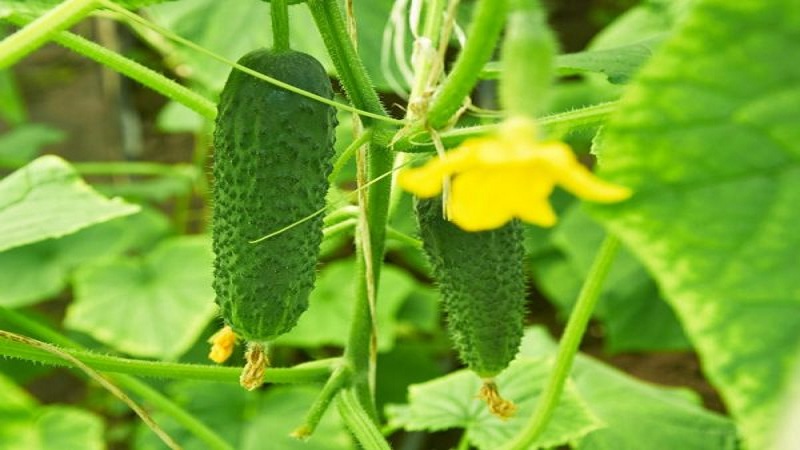
Distinctive features are presented in the table:
| Indicators | Characteristic |
| Ripening period | 42-45 days from the moment of emergence |
| Pollination type | Parthenocarpic (produces fruit without pollination) |
| Weight | 90-100 g |
| Length | 10-12 cm |
| The form | Cylindrical |
| Coloration | Dark green short stripe |
| Leaves | Medium green |
| Pulp | Juicy, crispy, no voids |
| Taste | Without bitterness |
| Skin | Dense, lumpy with white spines |
| Appointment | Universal |
| Yield | 12.8-14 kg / m² |
| Sustainability | Powdery mildew, olive spot, tobacco mosaic virus. Susceptible to downy mildew. |
| Transportability | High |
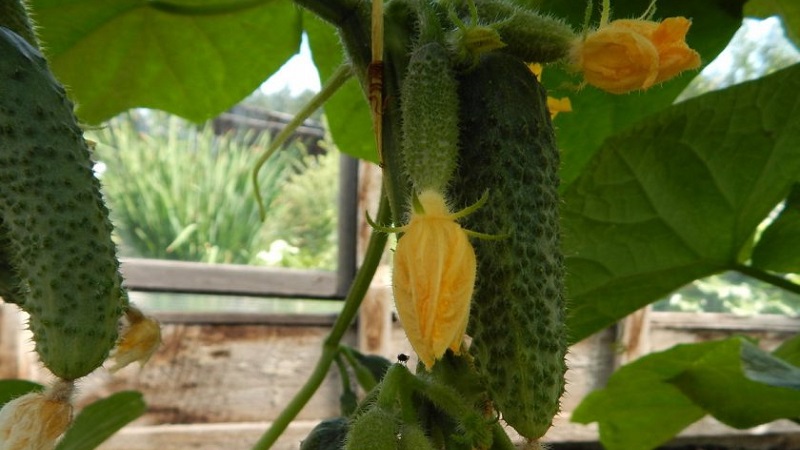
Chemical composition, KBZhU and the benefits of cucumbers
Nutritional value of cucumbers (per 100 g):
- calorie content - 14 kcal;
- proteins - 0.8 g;
- fats - 0.1 g;
- carbohydrates - 2.5 g;
- water - 95 g;
- fiber - 1 g.
Cucumbers are rich in vitamins (A, B1, B2, B4, B5, B6, B9, C, E, H, K, PP) and minerals (calcium, silicon, potassium, sodium, magnesium, sulfur, phosphorus, chlorine, iodine, iron, manganese, selenium, copper, chromium, fluorine, zinc).
Useful properties of cucumber:
- perfectly quenches thirst;
- relieves heartburn;
- replenishes the supply of vitamins and minerals;
- improves digestion;
- normalizes the thyroid gland;
- reduces puffiness;
- whitens the skin;
- lowers cholesterol levels.
Hybrid agricultural technology
Hybrid cucumber Shchedryk is grown seedling method in regions with cool summers and through sowing in the ground in the southern regions. The culture prefers light, fertile, loamy soil.
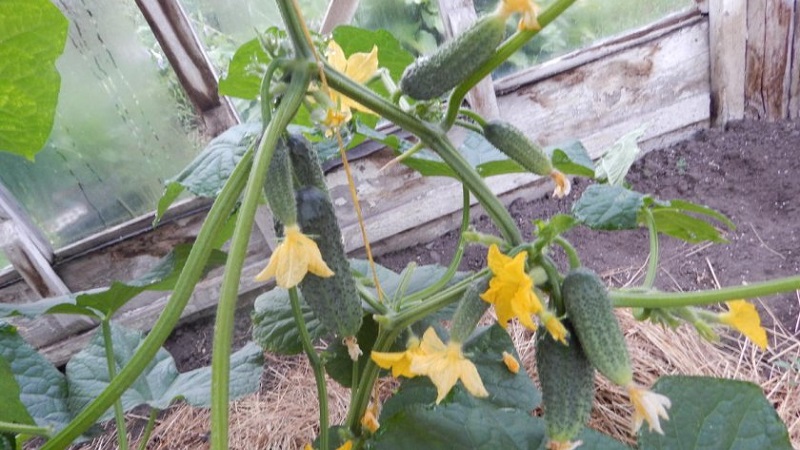
Plant care includes moderate watering, fertilization, loosening, weeding and mulching, as well as the prevention of downy mildew.
Planting through seedlings
Seeds of hybrids are not processed before sowing, since the material in packages is sold already disinfected.
To grow healthy and robust seedlings, use soil enriched with organic matter and minerals. For self-preparation, you will need 1 part of sawdust and 2 parts of humus and peat. For disinfection, the substrate is treated with a dark solution of potassium permanganate or "Fitosporin". The mixture is prepared in a large bucket and 30 g of ash and 25 g of nitrophoska or superphosphate are added.
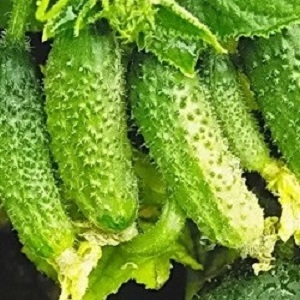 Seeds are sown directly into individual plastic or peat cups... The containers are filled with a moist substrate, one grain is placed in holes 2 cm deep and poured abundantly with water at room temperature.
Seeds are sown directly into individual plastic or peat cups... The containers are filled with a moist substrate, one grain is placed in holes 2 cm deep and poured abundantly with water at room temperature.
After the appearance of two leaves the seedlings are taken out on a sunny windowsill and fed with a solution: 45 g of nitrophoska per 3 liters of water. The hybrid is demanding on lighting, so when there is a lack of sunlight, the seedlings are helped by fluorescent lamps. The duration of daylight hours should be at least 15 hours.
Seedlings are watered abundantly once a week.... 10 days before planting, it is taken out into fresh air for hardening, gradually increasing the time from 20 minutes to 24 hours.
After 25-30 days, the seedlings are transferred to the ground... On the plot, holes are dug 5 cm deep and plants are planted with an interval of 50–70 cm.
Other varieties of self-pollinated cucumbers:
Early maturing cucumber Goosebump that does not require pollination
Cucumber-hybrid "Grandma's granddaughter f1": description and features
Seed growing
Cucumbers are a thermophilic crop, therefore, before direct sowing, it is advisable to make sure that the soil has warmed up to +16 ° С, and the air - to +23 ° С. Sowing activities are carried out in the last days of May.

The soil is prepared in autumn: dig up, disinfect with copper sulfate (1 tsp. per 3 l of water) and feed with humus (10 l per 1m²). In the spring, they re-dig, add humus, peat and wood ash in a ratio of 1: 1: 1.
Direct sowing is done in two ways:
- Row sowing... Seeds are laid with the "spout" down, 2 pcs. in each hole 3 cm deep, at a distance of 10 cm.The gap between the rows is 60 cm.
- Nest sowing... The holes are placed at a distance of 60–70 cm. The depth is 7–10 cm, the diameter is 8–10 cm. 7–10 seeds are placed in each groove and subsequently 5–6 strong shoots are left.
The soil after sowing is mulched with peat and generously moistened with warm rain or settled water. To protect against frost at night, the area is covered with agrofibre.
Important! For the cultivation of cucumbers, areas are chosen where zucchini, cabbage, onions, beans, peas previously grew.
Cultivation rules
The success of growing the Shchedryk hybrid and its productivity depend on compliance with the rules of care:
- Plants watered after sunset with warm, settled water 1-2 times a week.
- After each watering, the soil is loosened and weeds are removed.
- To reduce the frequency of weeding, the soil is mulched with peat, sawdust, hay or black agrofibre.
- Organic and mineral compositions are used as dressings.
- After planting (sowing), they are treated twice with fungicides to prevent fungal and bacterial infections.
- To improve the ventilation of the plantings, to facilitate plant care and harvesting, the lashes are tied to trellises.
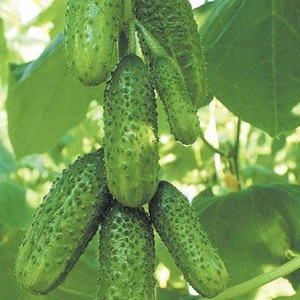 Cucumber feeding scheme:
Cucumber feeding scheme:
- the first - two weeks after disembarkation (sowing);
- the second - from the moment of flowering;
- the third - during the fruiting period;
- fourth (optional) - to extend the fruiting period and increase the yield.
First feeding option:
- organic - solution of chicken manure 1:15;
- minerals - 10 g of superphosphate, 10 g of urea, 10 g of potassium salt per 10 liters of water.
Option of the second feeding:
- organic matter - horse manure solution 1: 8;
- minerals - 5 g of ammophoska (sprinkle the beds and close up by loosening).
Option of the third feeding:
- organic - a solution of green fertilizers (infusion of tops, cut grass) 1: 5;
- minerals - 50 g of urea per 10 liters of water.
Option of the fourth feeding:
- infusion of rotten hay;
- 1 glass of wood ash per 10 liters of water;
- 25 g of soda per 10 liters of water.
Reference. Ash infusion can be applied every 10 days until the end of fruiting.
The nuances of growing and possible difficulties
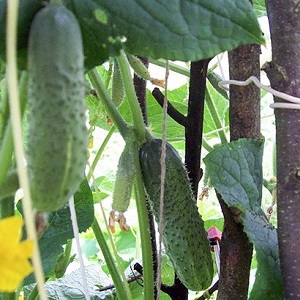 Hybrid Shchedryk f1 painfully tolerates stuffiness in the greenhouse, therefore, to create an optimal microclimate in the heat, the room is regularly ventilated.
Hybrid Shchedryk f1 painfully tolerates stuffiness in the greenhouse, therefore, to create an optimal microclimate in the heat, the room is regularly ventilated.
Excess moisture has a detrimental effect on the root system and leads to decay. The plant tolerates a lack of water more easily than an excess of it.
Bushes are prone to wilting and shedding of green massif you land them in a draft. To protect cucumbers from gusty winds, tall crops (corn, sunflower) are sown next to the plantings. Curtain crops form a protective wall behind which cucumbers feel comfortable and enter the fruiting period 4–6 days earlier.
Council. Sow outstretch plants 1-1.5 weeks before sowing cucumbers.
Diseases and pests
Hybrid Shchedryk is resistant to major cucumber diseasesbut prone to peronosporosis (downy mildew).
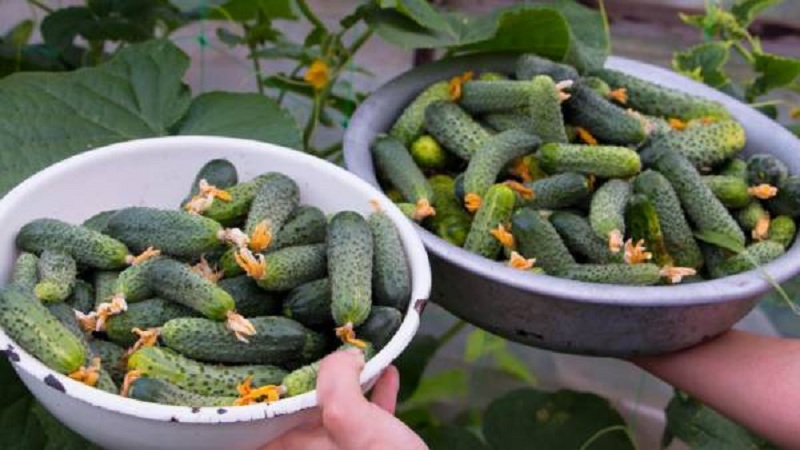
Signs of the disease:
- small brown or yellow spots on the front of the leaves;
- gray-purple bloom on the back;
- leaves turn yellow-brown and dry out.
The reasons:
- high air humidity and air temperature below +9 ° С;
- excessive watering with cold water;
- increased level of alkali in the soil.
Prevention:
- digging up the soil and disinfection with copper sulfate, potassium permanganate, "Gamair", "Fitosporin";
- removal of infected bushes with subsequent burning;
- weeding and loosening of the beds;
- compliance with the principle of crop rotation.
Treatment:
- treatment with chemicals at an early stage: 0.5% solution of Bordeaux liquid, "Ridomila", "Oxychoma";
- folk remedies based on ash, potassium permanganate, milk and iodine.
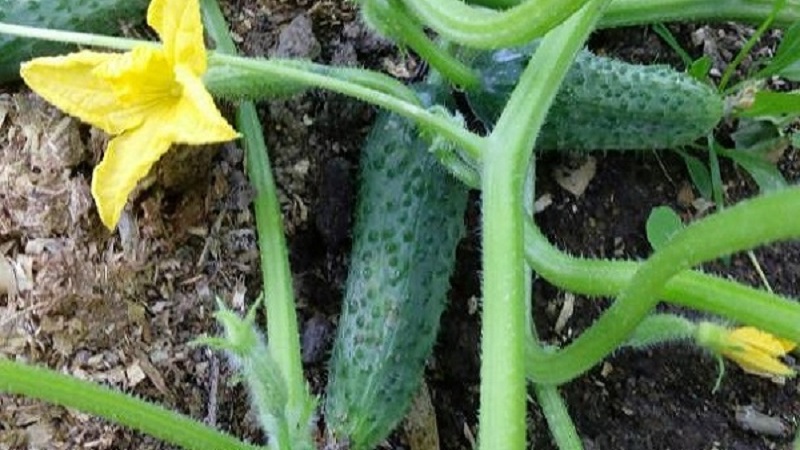
Recipes for folk remedies for downy mildew:
- 10 drops of iodine in 1 liter of low-fat milk, bring the volume to 10 liters. The solution is used to irrigate the bushes once every 7-10 days.
- 400 g of ash per 750 ml of boiling water, insist 3-4 hours and filter through cheesecloth. The volume is brought up to 10 liters and the bushes are sprayed once a week.
- 1 g of potassium permanganate per 10 liters of water. The solution is used to treat plants twice a month.
To get rid of insect pests (melon aphids, spider mite, Medvedki) use chemicals: "Fitoverm", "Aktofit", "Commander", "Aktara", "Nemabaktin", "Thunder".
Help fight slugs:
- traps from cans of beer (the smell of the drink attracts a pest);
- night spraying with ammonia solution (4 tablespoons per 10 liters of water);
- tobacco dust, rosemary, ground hot pepper, scattered on the beds.
Harvesting and application of the crop
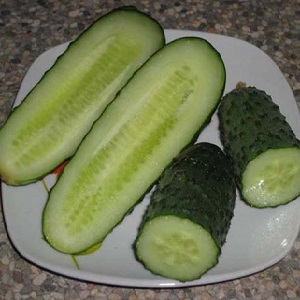 The first harvest begins approximately 45 days after germination... Up to 6 kg of cucumbers are harvested from one bush. Experts recommend harvesting continuously - this contributes to abundant fruiting.
The first harvest begins approximately 45 days after germination... Up to 6 kg of cucumbers are harvested from one bush. Experts recommend harvesting continuously - this contributes to abundant fruiting.
Fruits have firm flesh with few seeds... Thanks to the efforts of biologists, they do not taste bitter, and voids do not form inside. Thick and crunchy cucumbers are suitable for pickling, pickling, making lightly salted snacks and fresh vegetable salads.
The crop is stored in a cool place for up to three weeks without loss of taste and marketability. Well tolerates long distance transportation.
Advantages and disadvantages
Advantages:
- suitable for growing in protected and unprotected ground;
- characterized by abundant fruiting up to the onset of frost;
- parthenocarp with female flowers does not need pollination;
- fruits are of the same size, not prone to overgrowth;
- dense pulp is not bitter;
- high level of keeping quality and dense skin facilitate transportation without loss of presentation;
- the hybrid is resistant to most diseases.
Disadvantage - intolerance to high temperatures in the greenhouse and excess moisture in the soil.
Reviews
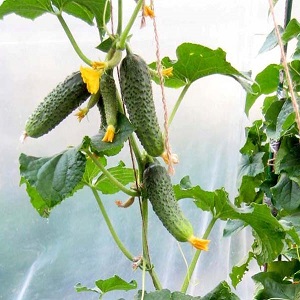 Reviews of farmers about growing the Shchedryk hybrid are mostly positive.
Reviews of farmers about growing the Shchedryk hybrid are mostly positive.
Larisa, Kursk: “I grow hybrid cucumbers only in the greenhouse. Among them is Shchedrik from Gavrish. I switched to the products of this company for a long time and I am satisfied. Cucumbers are absolutely undemanding to care for. With low labor costs, they can get a rich harvest. Fruits continuously until the end of September ".
Igor, Podolsk: “I have been planting cucumbers for several years in a row, the germination of seeds reaches 100%. I grow through seedlings in a greenhouse. I do not process the seeds. I tie the bushes to the trellis, do not form them. Taking care of the plant is easy.I water it abundantly once a week. I air the greenhouse in the summer ".
Varvara, Gukovo: “I grow the Shchedryk hybrid together with other varieties of cucumbers in the garden by direct sowing in the ground in early June. I cover the top with agrofiber for the night. Seedlings are friendly, abundant fruiting. Zelentsy are not prone to outgrowth. The pulp is dense, juicy, without bitterness ".
Conclusion
Cucumber Shchedryk is a high-yielding hybrid that allows you to collect up to 14 kg of selected greens from 1 m² or up to 7 kg from one bush. The culture does not require a special approach to cultivation. The seeds are sown directly into the ground in the southern regions. In regions with a harsher climate, cucumber is grown through seedlings.
To obtain a consistently high yield, the plants are fed with organic matter and minerals 3-4 times per season, providing abundant, but not frequent watering. The fruit is harvested regularly to achieve continuous fruiting.
The culture is resistant to most diseases, but is prone to infection with downy mildew. Compliance with the rules of agricultural technology (crop rotation, loosening, weeding, control of moisture levels) and preventive treatments with copper sulfate and "Fitosporin" can prevent the development of the disease.